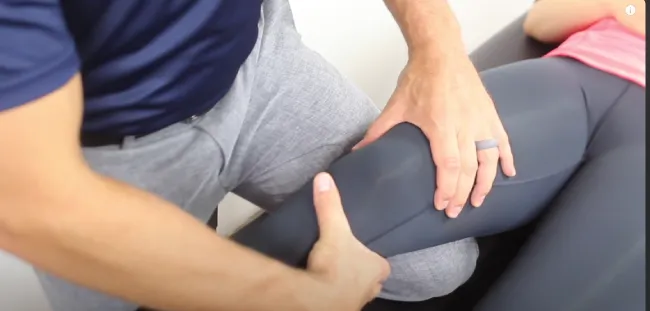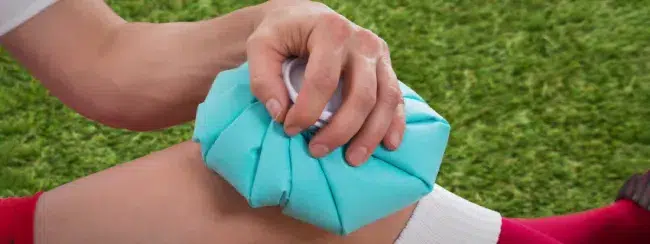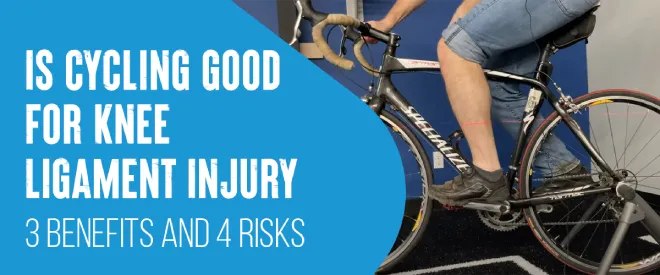Knee ligament injuries result from damage to the tissue bands connecting knee joint bones. They can be caused by trauma or sports injuries, leading to symptoms like pain, swelling, instability, and inability to bear weight.
Treatment options include medicine, exercises, braces, or surgery, depending on the severity and affected ligament.
Yes, you can manage knee ligament injury pain by cycling if you are looking for an alternative. Cycling offers some benefits. The exercise has a low impact on the joints and does not place as much strain on them as other exercises, such as running or jumping.
We will examine cycling as an effective and safe exercise for knee ligament injury recovery, highlighting the benefits and risks to consider when incorporating cycling into your physical therapy regime.
Is Cycling Good for Knee Ligament Injury? 5 Risks to Know

Cycling is a non-weight-bearing exercise that offers a range of benefits for those with knee ligament injuries. We will explore the various advantages of cycling and how it can support the healing process.
Low-Impact Exercise
Cycling is a low-impact exercise that creates minimal stress on the joints. This is especially important for knee ligament injuries, as excessive weight-bearing exercises or high-impact activities can cause further damage. Some of the advantages of low-impact exercise include:
- Reduction of joint wear and tear.
- Improvement of joint mobility.
- Promotion of cartilage health.
- The lowered risk of re-injury.
Muscle-Strengthening Exercise
Cycling is an excellent muscle-strengthening exercise that targets the quadriceps, hamstrings, glutes, and calves. They play a crucial role in supporting the knee joint and ligaments. When they are strong, they can help prevent future injuries. Some specific benefits of muscle-strengthening exercises like cycling include:
- Improving joint stability.
- Reducing pain and stiffness.
- Enhancing overall mobility and range of motion.
- Lowering the risk of osteoarthritis.
Non-Weight-Bearing Exercise
The exercise of cycling does not place undue stress on the joints. This is particularly important for people with knee ligament injuries, as weight-bearing activities can cause additional
strain and damage to the affected area. Some benefits of non-weight-bearing exercise include:
- Reduced inflammation and swelling.
- Better circulation and blood flow.
- Improved flexibility.
- Promotes faster healing.
Research Evidence
Substantial research evidence supports cycling as a safe and effective exercise option. In one study, researchers found that cycling was a low-impact exercise that promoted knee function and mobility in people with osteoarthritis. Other research has highlighted the potential for cycling to reduce pain and inflammation, increase muscle mass, and lower the risk of re-injury.
Type of Knee Ligament Injury Treated with Cycling
Knee ligament injuries are prevalent, particularly among athletes and active individuals, ranging from minor sprains to severe tears. The knee comprises crucial ligaments such as the Anterior Cruciate Ligament (ACL), Posterior Cruciate Ligament (PCL), Medial Collateral Ligament (MCL), and Lateral Collateral Ligament (LCL). Knowing the types of injuries and treatment options is crucial for effective rehabilitation, where cycling can play a significant role.
Anterior Cruciate Ligament (ACL)
ACL injuries, such as in soccer or basketball, are common in sports requiring sudden stops and changes in direction. While minor ACL sprains can respond well to conservative measures like rest, ice, compression, and elevation (RICE), significant sprains or tears necessitate immediate medical attention. Cyclists with ACL injuries can benefit from the low-impact nature of cycling during rehabilitation, aiding joint mobility and muscle strength without excessive strain on the ligaments.
Posterior Cruciate Ligament (PCL)
PCL injuries, though less frequent, can also be debilitating, often requiring surgical intervention for tears. Cycling provides a controlled environment for rehabilitation, allowing individuals to gradually regain strength and stability in the knee joint while minimizing the risk of further injury.
Medial Collateral Ligament (MCL) & Lateral Collateral Ligament (LCL)
Injuries to the MCL and LCL, commonly resulting from direct blows to the sides of the knee, may require rest, bracing, and physical therapy for recovery. Cycling can be an excellent option for individuals with MCL or LCL injuries, offering a low-impact cardiovascular workout while supporting the healing process.
Cycling and Knee Ligament Injury: 4 Risks
Cycling, often touted as a low-impact exercise, can be a double-edged sword for knee ligament injuries. While it may seem knee-friendly, certain risks should be considered. They should be mindful of this during their recovery journey.
Potential Aggravation of Pain, Swelling, and Inflammation
- Overexertion Concerns: Pushing too hard on the pedals may lead to increased pain, swelling, and inflammation in the affected knee.
- Listen to Your Body: Pay close attention to signals from your body. If discomfort persists, consider reconsidering the intensity of your cycling routine.
Risk of Further Damage with an Improper Bike Fit

- Importance of Proper Fit: A poorly fitted bike can contribute to improper biomechanics, potentially putting stress on the knee ligaments.
- Gear Selection Matters: High gears can amplify the strain on the knees. Opt for lower bags to reduce the risk of exacerbating your injury.
Re-Injury Risk If Knee Is Not Fully Healed
- Patience is Key: Rushing back into cycling before your knee is fully healed increases the likelihood of re-injury.
- Consult with Professionals: Seek guidance from healthcare professionals to determine the optimal time to reintroduce cycling into your rehabilitation.
Avoid Cycling Before Resuming Slowly
- Healing Takes Time: Allow your knee ligaments the necessary time to heal before considering cycling.
- Gradual Resumption: When given the green light by your healthcare provider, start with short, low-intensity rides, gradually increasing the duration and intensity.
Diagnosing Knee Ligament Injury

Knee ligament injuries can cause pain and restrict your cycling activities. An accurate diagnosis is crucial for appropriate treatment. Here’s how doctors identify if you’ve sustained a knee ligament injury while cycling.
Diagnostic Tests for Knee Ligament Injury
Knee ligament tests involve physical examinations in which the doctor cycles your knee in various ways to assess for injury. Beginning with manual tests, doctors proceed to advanced scans, delicately pressing and cycling your knee to identify areas of discomfort and determine range of motion.
Expect your doctor to pinpoint pain areas, evaluate knee mobility, and examine ligament stability for joint security.
X-ray Imaging
X-rays are quick and painless. X-ray test uses small amounts of radiation to create images of the bones in your knee. They help rule out other issues like fractures.
Key Points:
Fast and Non-Invasive: You’ll be in and out in no time.
Bone Health: X-rays show the condition of your knee bones.
Initial Step: Often, the first imaging test is done.
Magnetic Resonance Imaging (MRI)
Suppose your doctor suspects a soft tissue injury while cycling. They might order an MRI. An MRI provides detailed images of your knee’s soft tissues using magnets and radio waves. It’s more thorough than an X-ray, revealing everything from ligaments to cartilage.
Key Points:
Detailed Imaging: Gain a clear view of your knee’s interior.
Focus on Soft Tissues: Useful for evaluating ligaments.
Non-Radiative: A safe choice for most individuals.
Arthroscopy
At times, physicians may require a direct view of your knee. A surgeon inserts a small camera to provide an internal view of the joint. This is where arthroscopy plays a role. It is a minor surgical procedure that involves the use of a camera.
Key Features:
Live Visualization: Your surgeon gains an internal view of your knee.
Minimal Cuts: Only small incisions are created.
Versatile Functionality: It serves the dual purpose of diagnosis and, at times, treatment.
Cycling Good for Knee Ligaments: Additional Treating Options
Cycling can be a beneficial activity for those recovering from knee ligament injuries. It’s crucial to approach this with care and under the guidance of a healthcare professional. Let’s explore some treatment options, home remedies, and foods that can aid in your recovery process.
Treatment for Knee Ligament Injury

If you’ve suffered a knee ligament injury, here are a few methods that can help ease the pain and speed up the healing process:
Resting the Knee
Giving your knee a break is the first step towards recovery. Avoid activities that might further strain the damaged ligaments.
Ice Therapy
Applying ice to the injured area can reduce inflammation and numb pain. Remember not to apply ice directly to the skin. Use a cloth or towel as a barrier.
Compression
Wrapping your knee with an elastic bandage can provide support and minimize swelling. Don’t wrap it too tight, though, as it might obstruct blood flow.
Elevation
Try to keep your knee raised above heart level whenever possible. This helps to lessen swelling by encouraging fluid drainage.
Knee Bracing
Knee braces offer extra support and stability during the healing process. They also help prevent further injury.
Anti-inflammatory Painkillers
Over-the-counter anti-inflammatory drugs can help manage pain and reduce inflammation. Always follow the recommended dosage.
Home Remedies for Ligament Tear in Knee
In addition to the above treatments, some home remedies can assist in your recovery:
RICE Protocol (Rest, Ice, Compression, Elevation)
The RICE protocol combines four effective methods into a comprehensive at-home treatment plan.
Natural Anti-inflammatory Remedies
Turmeric, ginger, green tea, mustard oil, and cayenne pepper are natural anti-inflammatory remedies that can help reduce inflammation.
Heat therapy, Epsom salt, and eucalyptus should also be considered for their anti-inflammatory properties.
Herbal Supplements
Supplements can also help to reduce inflammation and pain. Always consult with a healthcare professional before starting any new supplement regimen.
Foods Beneficial for Knee Joints and Ligaments

The food you consume can play a significant role in your recovery. Here are some beneficial nutrients and where to find them:
Omega-3 Fatty Acids
Omega-3s in fish like salmon, flaxseeds, and walnuts can help reduce inflammation and promote healing.
Antioxidant-rich Foods
Foods like berries, spinach, and kale are antioxidants, protecting your cells from damage.
Vitamin C
Vitamin C, found in citrus fruits, strawberries, and bell peppers, aids in collagen production, a crucial component of ligament tissue.
Collagen-rich Foods
Bone broth, gelatin, eggs, fish, chicken, and beef are excellent sources of collagen, which is vital for ligament health and strength. To support collagen production and well-being, include citrus fruits, leafy greens, and beans.
Protein Sources for Tissue Repair
Lean meats, beans, legumes, eggs, shellfish, poultry, nuts, milk, protein bars, and wheat germ are good protein sources for tissue repair.
Cheese, leafy greens, legumes, and soy products also improve tissue recovery. Incorporating these foods into your diet
can support the repair of damaged tissues.
Conclusion
Cycling is an exemplary form of physical therapy with numerous benefits for knee ligament injury recovery and prevention. As a non-weight-bearing, low-impact exercise with muscle-strengthening properties, cycling can significantly enhance rehabilitation and reduce the risk of future injuries.
It is essential to remember that cycling comes with risks, including the potential aggravation of pain and inflammation, the risk of further damage due to improper bike fit or high gears, and the risk of re-injury.
Therefore, we recommend consulting a medical professional to increase cycling gradually, select smooth paths or indoor bikes, adjust the bike arrangement and posture, and adequately stretch before and after each session. Cycling can be an excellent addition to a physical therapy regime, but it is crucial to approach it carefully and cautiously.
FAQs
Is It Safe to Exercise with Damaged Knee Ligaments?
A graded exercise program may help you recover well from a minor injury. Try to get your knee moving usually once the damage has settled down. You can improve your walking by bending and straightening your knees gently.
What Type of Knee Ligament Injury Is Cycling Good for?
Cycling is beneficial for quadriceps rehabilitation and helps control stress on knee ligaments. The forces applied during pedaling can strengthen the anterior cruciate ligament, capsular ligaments, and posterior knee structures.
Cycling can benefit individuals with knee injuries looking to improve strength and mobility.
What are The Signs of A Torn Knee Ligament?
Signs of a torn knee ligament include a loud pop or popping sensation in the knee, severe pain, and rapid swelling. Other symptoms may include loss of range of motion, instability, or a feeling of giving way while bearing weight.
Do You Have A Sprain In Your Knee Ligaments?
Yes, you may have a sprain in your knee ligaments if you experience immediate pain after a direct blow or twist, along with pain during movement or activity in the knee, and notice swelling in the knee.
What Is The Recovery Period for A Knee Ligament Injury?
The recovery period for a knee ligament injury varies based on the grade of the tear. Grade 1 tears typically take 4-6 weeks to heal, grade 2 tears may need 6-10 weeks, and grade 3 tears may necessitate surgery.
What is The Difference Between A Tendon and A Ligament in The Knee?
A tendon moves bones or structures, whereas a ligament connects bones and stabilizes structures in the knee. Tendons help with movement, while ligaments provide stability. In the knee, tendons facilitate motion, while ligaments support and hold the joint together.


